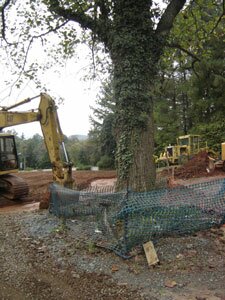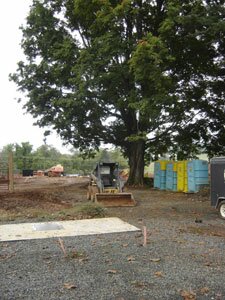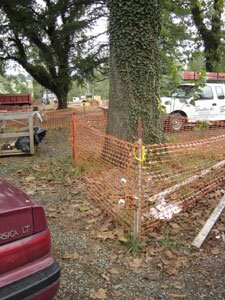ARB outrage: Tree angst at White Gables
White Gables is one of four gracious, tree-shaded mansions built along Ivy Road in the 1920s. Soon, instead of trees, 76 luxury condominiums in six pavilions will surround White Gables.
Not all the trees that once hid the house from the road have been cut down, of course. It's the health of those remaining trees that has Albemarle County's Architectural Review Board up in arms.
"It will completely change the landscape," says ARB member Candace Smith. "We're going to see these buildings up close and personal because these trees have been killed. I'm trying to be calm about it, but I'm completely outraged."
While the ARB claims that a dozen trees have been damaged, the contractor contends that only one tree is in danger of dying, and that several others are threatened– threatened by an ARB decision.
Smith describes the tree situation as a "disgrace" because the ARB based its site plan approval on protection of the existing trees. That means that a tree with a 60-foot-diameter canopy should have a snow fence underneath of the same dimension.
"In some instances, there was no protection at all," Smith says. "They allowed trucks and portajohns that compacted gravel underneath."
Most of a tree's feeder roots are in the top 18 inches of soil, explains Duane Snow, owner of Snow's Garden Center and also an Architectural Review Board member. "If you're compressing it with heavy trucks and equipment, water won't get to the roots."
Amy Arnold, then a landscape planner with Albemarle County, snapped photos of trucks and equipment parked underneath tree canopies. She estimates a dozen trees– oaks, poplars, and maples ranging from calipers of 24 to 48 inches– were damaged. The largest is a 48-inch oak that she says could be between 80 and 100 years old.
"They won't die immediately," says Arnold. "It will take two to three years. I don't think there's any doubt we'll lose several. They're showing signs of stress already."
Stan Binsted, president of contractor R.E. Lee & Son, says the photos of close-in fencing have to be considered in the context of the proximity of site plan work to the trees, including installation of new roadways, paths, storm sewer, sanitary sewer, and water and gas lines. And he points to a tree within a few feet of a driveway that would been impossible to fence off at full canopy size.
"Nowhere," protests Binsted, "has the county or an arborist said a dozen or more trees are in danger."
He produces a letter from certified arborist Dave Rosene with Van Yahres Tree Service that recommends removal of just one large tulip poplar.
"They've tried to be as conscientious as possible about root zones," says Rosene, who was hired to monitor the trees before ground was ever broken on the White Gables condos. "I speak for the trees," he adds.
Binsted argues that the ARB itself is endangering another poplar, a sycamore, and a 48-inch oak by requiring a lower land elevation for the site, which means it will be necessary to cut under those trees' roots during construction.
"The trees would have survived if they'd followed the original site plan, the original grading, the original building elevation and the original tree protection measures that were part of the plan," responds Smith.
She thinks at least four or five of the mature trees are goners, and says the ARB plans to require same species planting of any trees that die.
Meanwhile, the first completed White Gables condo pavilion should be ready for occupancy around December 1.

Is this poplar doomed? Contractor R.E. Lee concedes it might have to go, but takes issue with the ARB's allegation that the company has damaged a dozen trees during construction of condos at White Gables.
PHOTO BY BILLY HUNT

This tree's broad canopy provides a shady spot for latrines at White Gables.
PHOTO COURTESY ALBEMARLE COUNTY

The Architectural Review Board says fencing to protect a tree's roots should extend to the perimeter of its canopy.
PHOTO COURTESY ALBEMARLE COUNTY